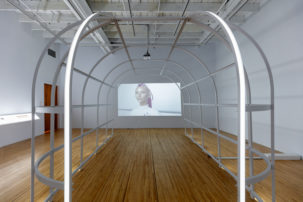Drawn to the strong image of a single human skull in a gallery window on London’s Cork Street, I walked into Flowers Central to discover a familiar Canadian name—James Lahey. Lahey’s latest exhibition, titled “Your Imperfect History,” is in many ways an extension of his 1990s Bone Paintings, which are based on human bones borrowed from the University of Toronto’s collection. Both bodies of work consist of photorealistic paintings of human bones set against black or dark grey backdrops. Although Lahey’s painting technique hasn’t changed—he methodically photographs each specimen from every angle in a ritualistic manner before beginning to apply paint and ink to canvas—his thought process has. This exhibition, consisting of skulls and accompanying text works, is personal. “For me it [the skull] is a symbol, a metaphor, for all those I have lost and remember,” writes Lahey.

| |
|
Installation view of James Lahey exhibition at Flowers Central London |
The skull paintings offer a contemplative meditation on life and death, but may also draw the viewer into an incessant and obsessive questioning of both. Four of the larger pieces in the exhibition have a text phrase, in various shades of grey, run across an image of a skull: “This can make you beautiful”; “Your imperfect history”; “You are comfortable with your contradictions”; “You want to start over.” “I realized that the skull would always be the ‘other,’” Lahey states, “because we only imagine ourselves as flesh. I needed a way to adjust this reflection and make it circular in order that the ‘other’ could become us—at least for a moment.” This effect is achieved by the placement of three skull paintings on one side of the gallery and three pieces of polished steel with inscriptions sandblasted into them directly opposite each skull on an adjacent wall. Looking into the steel, as a mirror, viewers encounter a phrase, a skull and themselves, which immediately links the three together.
The final work in the exhibition, Not for Finding, was completed a few years back. It is an altar-piece-style triptych consisting of close-up ink images of bare tree branches against a white background; inside the altar piece, however, one finds a skull, slightly blurred, mouth wide open, ready to jump out and latch onto the viewer, like a jack-in-the-box from a horror movie. The exhibition is a contradiction: it is incisive, sinister, meditative, paranoid and transformative. It forces the viewer to come face to face with their questions and beliefs about death and existence, which can ultimately have a transformative effect. It is one skull that Lahey used as a model for all his works—all is one in the end.
| <img src="/online/reviews/2008/10/09/lahey3_376.jpg" alt="James Lahey you want to start over (v3) 2008″ style=”border: none; clear: none;” /> | |
|
James Lahey you want to start over (v3) 2008 |










